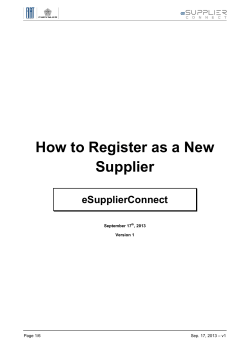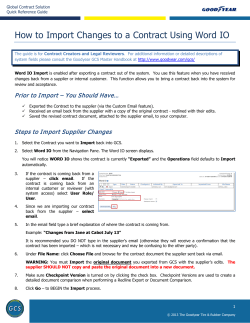
Document 268185
Supplier Diversity Best Practices White Paper Presented by SuPPoRTing economic deVeloPmenT. Helping the Valley’s many communities thrive is at the heart of everything we do. After all, we live here too. For more than 100 years, SRP has supplied the Valley with water and energy. Besides being a steward of these crucial resources, SRP continues to invest in the area through educational partnerships that develop a skilled workforce to attract businesses to the Valley. Whether it’s economic development, the environment, human services, education or the arts, SRP is committed to helping our many communities prosper for generations to come. To learn more, visit srpnet.com/econdev. Supplier Diversity Best Practices White Paper presented by Arizona Hispanic Chamber of Commerce November 2013 researched and written by Mike Slaven & Robert D. Esquivel Supplier Diversity Best Practices White Paper 1 Acknowledgments Acknowledgments Committee Ricardo Carlo Associated Minority Contractors 2012 Inductees of America Jesus Borboa, Frank Celis, Jesus Borboa Alika Kumar Phoenix MBDA Business Center Gonzalo A. de la Melena, Jr. Arizona Hispanic Chamber of Commerce Valerie Churchwell, of Petra Nixon Arizona Public Service Lorena Valencia Alex Juarez, Gladys Lopez, Rosemary Middleton, Patti Pyle, Reliance Wire Pamela Williamson, Ph.D. Women’s Business Enterprise Council – West Chester Yancy Arizona State University AZHCC Staff Contributors Robert D. Esquivel, Consultant James E. Garcia Communications Consultant Carmen G. Martinez, Graphic Designer Terri Morgan, Director of IT & Digital Media Mike Slaven, Consultant Monica Villalobos, Vice President Ken Refner, of America Walmart CenturyLink American Express Hensel Phelps Construction Salt River Project University of Phoenix AT&T Arizona State University Community Partners Kerwin V. Brown, Phoenix Black Chamber of Commerce Scott Gregory Grand Canyon Minority Supplier Development Council Madeline Ong -Sakata, Loren Tapahe, Asian Chamber American Indian Chamber Barry Wong, Chinese Chamber Printing courtesy of 2 Bank Scott September, Chester Yancy, Phoenix, Aviation Cox Communications Kevin Jost, Commerce of Sundt Construction Carlos Gonzalez, Julio Herrera, PepsiCo City Marian Enriquez, Ted Namba Asian Chamber Southwest Gas Jaime Chon, Arizona Public Service Miguel Bravo Arizona Public Service Arizona Public Service Supplier Diversity Best Practices White Paper of of of Commerce Commerce Commerce FOREWORD welcome to SDWP REPORT Arizona is home to an estimated 100,000-plus minority-owned business enterprises, two-thirds of which are Hispanic-owned, contributing billions annually in revenue to the state’s economy. Couple that with the tens of billions in purchasing power by minority communities and it’s clear the state’s demographic shifts have birthed a rising economic powerhouse in Arizona that cannot be ignored. Notably, the already substantial impact of minority-owned businesses is growing at a phenomenal rate. The number of businesses owned by Hispanic women, for instance, are growing three to four times the national average of non-Hispanic-owned firms. Hispanic-owned businesses are expanding at a rate two to three times the national average, while Asian American-owned companies are recording historic growth as well. Corporate Arizona is taking notice of this enormous and growing potential. Most major companies now understand that engaging a diverse supply chain is not only the right thing to do, but a practical economic necessity that can boost their bottom line. Getting minority-owned companies into the pipeline of the supplier diversity chain, however, requires community-wide, proactive and cooperative initiatives by the state’s major corporations, small businesses and other pro-business organizations. To help support of such initiatives, the Arizona Hispanic Chamber in 2012 partnered with a wide array of minority and non-minority chambers of commerce and economic development organizations and launched the Million Dollar Circle of Excellence. The project recognizes Arizona-based companies doing at least $1 million worth of business with minority- or women-owned firms in the state. The following white paper presents an overview of best practices that can maximize opportunities in the supply chain. For those companies that do not yet have a supplier diversity measurement program, the information contained in this white paper may serve as a guide to begin that process. This paper is the latest in a series of reports published in the past two years by the Arizona Hispanic Chamber offering impactful, data-based market research about minority-owned businesses and consumers for state business leaders and public officials to use in developing economic policy. The series has featured research on minority-, Hispanic-, women-, and family-owned businesses, as well as the 17th Annual DATOS: The State of Arizona’s Hispanic Market report and DATOS Tucson. The Arizona Hispanic Chamber of Commerce thanks its corporate partners for assisting authors Mike Slaven and Robert Esquivel in the preparation of this report, and hopes you find the information useful in your efforts to achieve a diverse and profitable supply chain. Gonzalo A. de la Melena, Jr., MBA President & CEO Arizona Hispanic Chamber of Commerce Supplier Diversity Best Practices White Paper 3 Freeport-McMoRan is pleased to support the Arizona Hispanic Chamber of Commerce and its efforts to promote the success of Hispanic-owned and small businesses. We are committed to supporting partnerships today that lead to a stronger community and economy tomorrow. Visit www.FreeportInMyCommunity.com or scan the QR code to learn about our commitment to communities. table of contents table of contents ACKNOWLEDGMENTS 2 welcome 3 EXECUTIVE SUMMARY 7 Supplier Diversity as a Business Imperative 8 Addressing Supplier Diversity’s Major Challenges 10 Fostering Support Among Management 11 Having Your Purchasing Organization Embrace Supplier Diversity 14 Mastering The Landscape Of Diverse Suppliers 17 Developing A Qualified Diverse Bidder Pool 20 Ensuring Supplier Diversity Improvements Are Achieved 23 Making Sure Diverse Spend Flows Down 25 further resources 28 Best Practice Matrix 31 Supplier Diversity Best Practices White Paper 5 Services that create results for you! We provide strategic business consulting; access to capital; bonding; contracting opportunities; teaming; minority certifications; workshops and B2B forums! The Phoenix MBDA Business Center is focused on securing large public and private contracts and financing transactions, stimulating job creation and retention, and facilitating entry to global markets for eligible minority-owned businesses (MBEs). MBC serves eligible MBEs with annual revenues of over $1,000,000 or, firms in a highgrowth industry (e.g. green technology, clean energy, health care, infrastructure and broadband technology, among others). 255 East Osborn Road, Suite 202, Phoenix AZ 85012 I 602-248-0007 I www.ph oen ix m bdac ente r .c om Operated by the Arizona Hispanic Chamber of Commerce executive summary EXECUTIVE SUMMARY From its origins as a compliance matter, supplier diversity is increasingly becoming a business imperative, as demographic shifts change the face of American business owners. Maximizing opportunities in the supply chain means staying on top of what a growing group of minority- and women-owned businesses have to offer. Building a high-quality, competitive supplier pool means tapping the potential of this growing segment of businesses — which often are outside the status quo of companies’ procurement practices, and whose successes are increasingly crucial to the prosperity of our communities. Building on the work of the Arizona Million Dollar Circle of Excellence (AZMDCE), launched in 2012, this white paper serves as a brief guide to how leading companies have worked to create great supplier diversity programs in the face of common challenges. We were generously assisted in this project by nine corporate partners of the Arizona Hispanic Chamber of Commerce: Salt River Project, Arizona Public Service, Hensel Phelps Construction, Southwest Gas, Raytheon, CenturyLink, Bank of America, Arizona State University, and the City of Phoenix Aviation Department. Drawing on the experience of these partners, the goal of this white paper is to: • Give companies that are looking to start setting up a strong program a sense of the major challenges; • Sketch what kinds of actions could be taken to address these challenges; and • Provide some information where companies can go for further information and support. In considering the obstacles to setting up a strong program, we discuss six general, primary challenges that have to be addressed for a supplier diversity program to work well: • Fostering support among management • Having your purchasing organization embrace supplier diversity • Mastering the landscape of diverse suppliers • Developing a qualified diverse bidder pool • Ensuring supplier diversity improvements are achieved • Making sure diverse spend flows down For each of these, this white paper provides three best practices to help overcome the challenge — outlining both initial steps to take, and more advanced ones to consider. Fostering support among management is critical if a supplier diversity program is to have adequate resources, and if supplier diversity is to be taken seriously as a priority company-wide. It is important for a supplier diversity manager to make the most effective business case for supplier diversity, in consideration of the company’s culture and strategic objectives. A supplier diversity team also should continually engage with executives using proven methods such as establishing a steering committee, and should leverage both internal and external allies to help continually make the case for supplier diversity. Having a purchasing organization embrace supplier diversity is crucial simply because procurement staff have control over spending. Working with them to advance supplier diversity means acknowledging and managing the fact that introducing supplier diversity expectations can mean disruptive change in relationships with existing suppliers. Supplier diversity managers should look to educate buyers and provide them with tools to do their jobs, treating them as internal customers. A supplier diversity manager should look to build relationships based on trust with buyers, and to capture their energy by tapping into their competitive spirit to meet and exceed goals. Mastering the landscape of diverse suppliers is challenging because many qualified diverse suppliers will be hard to find or will fly under the radar in the absence of purposeful attempts to find them. Supplier diversity managers should network strategically, attending events conferences in order to form relationships — perhaps with suppliers the company may not utilize for years. A supplier diversity program should leverage external community partners, such as minority chambers of commerce and certification organizations, who can expand companies’ capabilities and help them find competitive contractors. They should also connect with other corporate supplier diversity programs and take advantage of their colleagues’ willingness to help improve their network. Supplier Diversity Best Practices White Paper 7 supplier diversity as a business imperative Developing a qualified diverse bidder pool means expanding the capacity of high-potential women- or minority-owned businesses to the point where they can compete strongly on the open market for larger-scale work. To begin with, a supplier diversity program should always provide feedback to diverse enterprises that lose bids or are not ready, teaching them how they can improve. Companies should create educational programs to develop suppliers: These can range from seminars to introduce diverse suppliers to a company’s buying culture and procedures, to extensive business training that helps them to expand capacity. Companies can also get their prime contractors involved in the development of diverse enterprises whom they can both work with in the future. Ensuring supplier diversity improvements are achieved means making sure that the programs put in place are actually achieving results. This entails developing a written strategy, roadmap, and budget that have been scrutinized analytically. It also includes working with the procurement organization to ensure that buyers are accountable for their supplier diversity outcomes, and that the company adopts metrics to measure the success of its supplier diversity programs so that it can correctly focus its efforts. Finally, making sure diverse spend flows down is critical if a corporate commitment to supplier diversity is to yield benefits throughout the supply chain and throughout a local community. This means establishing expectations for prime contractors’ commitments to supplier diversity, creating a reporting system for second-tier spending, and always working with the procurement staff to ensure that large contracts make room for small business participation. In pursuing the goal of a robust supplier diversity program, businesses also can take advantage of a number of resources and organizations — some of which are described in an appendix on further resources. Supplier Diversity as a Business Imperative “There are a lot of companies out there that we could partner with for our mutual advantage.” — Patti Pyle, Supplier Diversity Manager, SRP Many companies began supplier diversity programs in past decades as a compliance matter, in order to follow regulations for government contracting. Over time, though, more and more companies have started programs as the business case for supplier diversity has become clearer. Companies today are choosing to pursue a diverse supplier pool simply because, in the face of sweeping demographic trends, doing so is a smart business practice that figures importantly in an advanced supply chain management strategy. In Arizona in particular, a huge amount of new economic activity is being driven by minority- and womenowned businesses. Demographic change forms the backdrop to the economic changes that are making supplier diversity programs more critical to everything businesses source. The economy is generating a plethora of small minority- and women-owned businesses whose potential is waiting to be tapped. In Arizona, there are an estimated 100,000 minority-owned businesses or 25% of all businesses, growing at a rate 2-3 times faster than non-minority-owned firms, according to the Arizona Hispanic Chamber of Commerce’s 2012 Minority Business Enterprise Report. 8 Supplier Diversity Best Practices White Paper supplier diversity as a business imperative Maximizing opportunities in the supply chain means a company has to stay on top of what this growing group of businesses has to offer. Many corporate purchasing organizations, however, will not be primed to do this without a well-run supplier diversity program. Most minority and women-owned businesses are small, with four or fewer employees, according to the research firm Geoscape. Many are just starting to grow, and need to take initial steps to develop capacity before their competencies can be put to use by large businesses. Since purchasing processes often build from existing supplier relationships, the supply-chain potential resting in minority businesses will often fly under the radar without a program dedicated to seeking it out and developing it. More precisely, there are five main reasons that supplier diversity managers identified for why supplier diversity programs were important to the success of their businesses: Finding and building the most-qualified possible supplier pool Knowing whether your company is getting the best possible product and price from suppliers means continually surveying what the marketplace is offering. Buyers in corporate procurement will often see that marketplace as consisting primarily of suppliers that are already known to them, or suppliers who are marketing themselves actively. The growing universe of small diverse businesses can exist quite apart from this, even if many such potential suppliers could offer good value or innovative approaches. Supplier diversity programs help to bridge this gap. As Chester (Chet) Yancy, manager of Small Business and Diversity Programs at ASU, explains about this group of diverse enterprises, “Most of these businesses are good at what they do — but they may not be good at selling themselves.” Getting the best value out of the supply chain means identifying the potential in these companies, which are often run by small businesspeople. Many small businesses don’t have the time or resources to focus on strategic initiatives that might otherwise lead them to realize the opportunities that could exist if they took the first step through a major buyer’s front door. Through the work of supplier diversity programs, corporate buyers can more readily understand what this group of supplier has to offer, and how this fits into their procurement needs. Increasing competitiveness among suppliers Identifying and cultivating a greater number of qualified suppliers will increase the competitiveness of the bidding process — helping companies to bargain for higher-quality services and lower prices. It also helps to keep prime suppliers on their toes, and reduces the complacency that can lead to a company not getting the best value from its suppliers. “What they do through the competitive bid process we view as a cost savings,” says JD Calhoun, senior analyst with the supplier diversity program at Southwest Gas. “That’s what it’s about, and everybody wins.” Meeting customer demands For companies that pursue business with clients who look for supplier diversity commitments — whether these clients are government agencies or in the private sector — an ability to demonstrate a diverse supplier base is a core part of competitiveness in bidding for contracts. “Being able to meet customer demands is a component of the firm being competitive in the marketplace,” says Rosemary Middleton of Hensel Phelps Construction. If a client asks for a certain portion of direct spend to be with diverse businesses, “we will sometimes go in with a higher goal — and if this is important to the client, then it is a beneficial thing to the bid.” Supplier Diversity Best Practices White Paper 9 addressing supplier diversity’s MAJOR challenges Reducing risk in the supply chain What happens if a prime contractor falls short? This is much less of a problem if a supplier diversity program has helped to identify further qualified suppliers, even ones that the company hasn’t yet done business with. As Mike Angulo of SRP explains, “If we have more qualified suppliers, it enriches our supply pool.” This provides greater flexibility to a business and allows it more options if a prime supplier does not deliver according to expectations. Building community prosperity The increasingly diverse demographics of Arizona (and the country as a whole) mean that diverse businesses support the livelihoods of more and more families in our communities. Many companies see doing business with these enterprises as a crucial part of their strategies for helping to develop the economies of the communities they serve, which in turn increases demand for their products. Doing so also provides an important linkage to the growing base of diverse consumers. “We want to make sure that we’re affecting the economic development in our local communities,” says Angela NorrisHawkins, supplier diversity manager for CenturyLink. “There are benefits to the corporation: Brand visibility leads to loyalty, which leads to increased customer interaction, hopefully, which leads to us getting access to a diverse market. It’s a circle of success.” Across industries — and across companies — there are many individualized cases for why supplier diversity is important to meeting business objectives. Not all of the above will apply to every company, and companies in some industries may find pressing sector-specific reasons for developing diverse suppliers. Beyond the general reasons provided above, it’s important to understand what value a diverse supply pool offers to each particular company, and to build each company’s business case according to its unique circumstances. Indeed, having a supplier diversity strategy can aid the success of any large business entity, whether it is privately or publicly driven. Addressing Supplier Diversity’s Major Challenges Achieving results in supplier diversity is not an easy task. It does not simply mean creating a corporate goal, and it does not consist just of setting up a software program to track spending. Supplier diversity managers from leading companies all stress that creating a good program requires time and persistence: It’s about having a tireless attitude, continually demonstrating the value of supplier diversity to the company, and doing hands-on work to build a bridge between a company’s buying habits and diverse suppliers who currently are outside the loop. If creating a good supplier diversity program is hard, however, those companies that are presently at the earlier stages in doing so have an advantage: There are others who have come before, and they are an 10 Supplier Diversity Best Practices White Paper challenge: fostering support among management open book about how they’ve addressed the difficulties they’ve faced. The following material is based heavily on the advice we heard from experienced supplier diversity managers. We discuss six key challenges to grasp in moving a supplier diversity program forward — and, for each of them, we offer a number of proven methods that can help supplier diversity programs make progress and achieve results for their companies. Challenge Fostering Support Among Management “One of the things you have to have from the very beginning is support from the top. You have got to have your executive leaders on board with what it is that you’re doing. If you don’t have that, you’re pretty much spinning your wheels.” —Valerie Bailey, Southwest Gas The Challenge It’s basically unanimous within the supplier diversity world that without the support of company management, building a well-working program is impossible. Management needs to support supplier diversity efforts in order for people throughout the organization to understand the importance of supplier diversity goals to the company. Visible support from the top is necessary in order for employees to feel that their progress on the issue will be valued and scrutinized. Supplier diversity teams need also adequate resources — personnel and funding — in order to do their jobs. These become very difficult to obtain if leadership doesn’t value what supplier diversity managers do. It’s unlikely that a company will take serious steps toward improving the diversity of its suppliers without some interest from management. It’s also unlikely, however, that the energy it takes to set up a nascent program can sustain the program for long or be sufficient to elevate it to higher levels. Existing support among executives needs to be nourished, and support among management must be continually cultivated. Supplier Diversity Best Practices White Paper 11
© Copyright 2025









